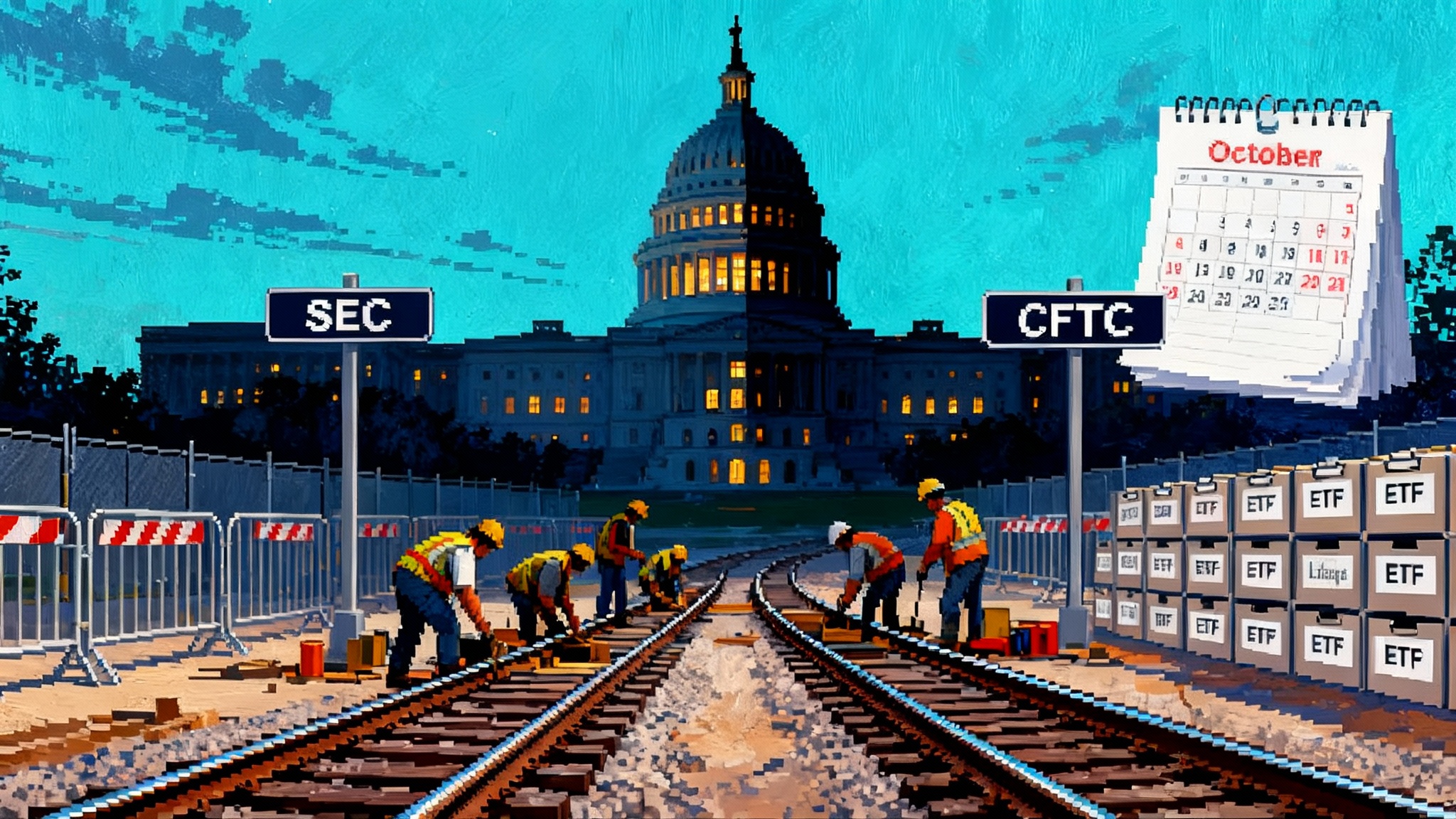After GENIUS, Banks Race to Mint the Compliant Digital Dollar
The United States GENIUS Act, signed on July 18, 2025, gave stablecoins a national rulebook. By October, major banks were prototyping G7-pegged tokens. Here is who wins and loses, how payments and yields realign, and a builder playbook for the next 18 months.

The aftershock that changed the money layer
On July 18, 2025, the United States locked in a nationwide rulebook for payment stablecoins when President Donald J. Trump signed the GENIUS Act into law. The statute made a simple promise feel real: if you hold a regulated one dollar token, you can redeem it for one dollar because it is backed by cash and short term Treasuries and reported with strict transparency. That clarity flipped a switch for banks, exchanges, and payment apps. The market had asked for rules. It got a blueprint with enforcement teeth, a shift we foreshadowed in our coverage of the Senate stalemate. White House fact sheet on the signing.
By October, the signal had been received. A cross border group of major banks publicly began exploring stablecoins pegged to G7 currencies. They framed it as research. In practice it looked like a race to package bank grade balance sheets into programmable money and settle in seconds across chains and markets. Reuters on banks exploring G7 pegged coins.
If you want the shortest way to read the moment: the United States just turned stablecoins from a gray market tool into a regulated payments instrument. That does not kill the offshore market overnight. It does change the gravity of crypto’s money layer for the next cycle.
The GENIUS Act in plain English
The law draws a bright line. A payment stablecoin is a token meant for payments and settlement, redeemable at a fixed amount like one dollar. If you issue it to United States users or list it in a United States market, you must:
- Hold one dollar of approved reserves for every token outstanding. That is cash, insured deposits, short dated United States Treasuries, certain government money market funds, or repo collateralized by Treasuries.
- Publish regular disclosures and submit to supervision. Federal or qualifying state oversight is required, with audits and record keeping.
- Follow anti money laundering and sanctions rules. Know your customer and screening are not optional. Issuers must be able to comply with lawful orders to freeze or claw back tokens.
- Ring fence customer assets. Reserves cannot be commingled. In an insolvency, token holders have priority claims on the reserves.
- Work within a timeline. There is an implementation runway that effectively stretches out to January 18, 2027 unless regulators finalize rules earlier. Exchanges, custodians, and wallet providers have a transition period to restrict their listings and flows to permitted stablecoins.
The headline is confidence. The law does not bless every coin. It describes the minimum structure that earns the right to circulate in regulated markets and inside large enterprises.
October’s bank moves were not a coincidence
Bank treasurers understand two things better than most crypto teams. First, trust is a yield curve question, not a marketing question. Second, deposits and near cash instruments are a bank’s home field. The GENIUS Act lets banks play on chain with their core product. That is why October delivered news of banks exploring dollar, euro, pound, yen, and Canadian dollar tokens. It is easier to build a compliant coin when you already own the compliance stack and the balance sheet.
Think of it like sports. For years, crypto native issuers ran fast on an empty track because the stadium owner had not unlocked the gates. The law just opened the gates. The teams with the best cleats and the biggest locker rooms sprinted in.
Who wins, who loses
Winners
- Bank issued dollars. If a money center bank issues a token fully backed by cash and Treasuries, most institutions will treat that token like overnight cash with instant settlement. Treasury desks can sweep, settle, and reconcile with fewer hops and lower counterparty risk. Corporate treasurers can move working capital between platforms in minutes instead of days.
- Compliant USDC and other permitted issuers. Circle spent years building as if this bill would pass. Expect permitted issuer status, stronger banking partners, and deeper integration into point of sale, payroll, and enterprise resource planning modules. Payment apps and broker dealers will prefer tokens that come with clean examiner conversations.
- Domestic exchanges and fintechs that align early. If you restrict to permitted coins, you can add features that were off limits before: direct payroll, card settlement, and business to business invoicing that books in real time.
Losers
- Unlicensed offshore stablecoins in United States venues. Nothing stops global users from holding offshore tokens. But the United States venue prize pool will shrink for those coins. As exchanges, brokerages, and payment apps complete their transition periods, they will delist or geofence coins that cannot meet issuer, reserve, and compliance requirements.
- Shadow banking wrappers. Tokens that used opaque commercial paper, synthetic hedges, or exotic yield paths to promise a dollar will get squeezed. The law creates a clean room. If your reserves cannot sit comfortably next to a Treasury bill, the door closes.
- Purely anonymous retail flows inside regulated apps. The law pulls identity and tracing into the base layer of consumer facing products. That will divert privacy seeking users to peer to peer tools, but it will make compliant flows safer and more credit worthy for businesses.
How payments, DeFi yields, and RWA rails realign
On chain payments
- The cash drawer moves on chain. Merchants and software platforms will keep part of their treasury in permitted stablecoins. This allows instant supplier payouts, real time payroll, and cross border settlement without correspondent banks. Expect accounting systems to treat permitted coins as cash equivalents with automated reconciliation, a trend reinforced by the Samsung and Coinbase onchain push.
- Message and money converge. Payment instructions and token movements share a ledger and a timestamp. Chargeback risk gets lower because settlement finality is programmable. Refunds become explicit smart contract flows instead of manual tickets.
DeFi yields
- Yield separates into two stacks. Low risk base yields come from tokenized Treasury funds, repo, and regulated lending vaults. Higher risk yields come from basis trades, leverage, and algorithmic markets. The new rules pull a wall between them. Banks and permitted issuers can offer the base stack to institutions that need predictable earnings. The risk stack survives, but it migrates to venues that can certify user sophistication and jurisdiction.
- Collateral quality improves. When margin calls hit, the ability to liquidate a permitted coin for one dollar at a bank improves system stability. That makes leverage cheaper for counterparties that post permitted coins, which will nudge trading desks to switch collateral.
RWA rails
- Tokenized deposits meet tokenized funds. A bank issued dollar token can plug into a tokenized Treasury fund and a tokenized commercial paper facility. Overnight sweeps become a smart contract routine. The return is not a DeFi airdrop windfall. It is the bank grade two to five percent you wanted with instant liquidity and audit trails.
- Supply chain and trade finance revive. When invoices, inventory, and cash sit on interoperable ledgers, receivables financing can clear in hours. Expect the first at scale wins in industries that already live on thin margins and tight cash cycles, like electronics distribution and logistics.
The eighteen month map
October to December 2025
- Banks finalize pilots and sandboxes. Expect proofs of concept with controlled user groups and a handful of chains. The goal is to test mint, redeem, freeze, and report. Real time attestations of reserves become table stakes.
- Exchanges and wallets tag their migration plans. Product managers reorganize around a permitted coin core and chain agnostic settlement. Compliance teams update risk matrices to favor permitted issuers.
January to June 2026
- First public bank tokens appear in limited circulation. Treasurers trial supplier payouts and overnight sweeps in permitted coins. On chain settlement messages begin to mirror traditional payment messages for easy reconciliation.
- DeFi forks for institutions. Expect permissioned pools that accept only permitted coins and whitelisted addresses. Programmable disclosure becomes a selling point, not a burden. Vaults with automated 1099 like reporting gain traction with small businesses.
July to December 2026
- Cross currency rails arrive. With euro, pound, and yen tokens in pilot, treasury desks test atomic swaps for foreign exchange. Spreads compress where market makers can lock in price and settlement in one move.
- Consumer wallets shift from anonymous addresses to embedded identity proofs. Users opt in to share verified attributes for larger limits, chargeback rights, and faster dispute resolution, a pattern foreshadowed by the TON U.S. wallet onramp.
January 2027 to the effective date
- The switch flips. As the law takes full effect, United States venues restrict listings and flows to permitted coins. Liquidity migrates. Offshore coins continue in offshore venues, but onshore books standardize around bank issued dollars and a small set of permitted non bank issuers.
The builder and exchange playbook
- KYC native wallets
- What to do: Build wallets that can bind know your customer identity proofs to addresses and revoke or rotate keys without losing compliance state. Support progressive disclosure. A user can prove residence or business status without exposing full documents to every counterparty.
- Why: The law bakes identity into the base coin. Abstract the friction in your user interface and your product will feel faster than legacy bank onboarding.
- How: Use verifiable credentials for identity attributes and design smart contracts that accept transfers only from addresses with valid proofs. Keep a compatibility mode for peer to peer flows that do not need enterprise features.
- Tokenized deposit rails
- What to do: Connect to banks that issue tokenized deposits and permitted stablecoins. Treat both as first class assets in your treasury and customer flows.
- Why: Deposits and permitted stablecoins will coexist. Some banks will tokenize deposits for account holders while also distributing a public stablecoin. Your platform should sweep between the two depending on the customer’s risk and reporting needs.
- How: Offer automated policies. For example, keep operating cash in a bank token during business hours, sweep excess into a tokenized Treasury fund overnight, and refill the stablecoin float before payroll.
- Chain agnostic settlement
- What to do: Build a settlement layer that can route the same payment across multiple chains and bridges, with a target time and fee. Expose a single API to merchants and treasurers.
- Why: Banks will not agree on a single chain. You win by abstracting the choice. If a network stalls or fees spike, your router retries on another rail.
- How: Maintain proof of payment receipts off chain with hash anchors on chain for auditability. Build a policy engine that chooses rails by cost, latency, and counterparty preferences.
- Surveillance sharing on your terms
- What to do: Stand up a privacy aware sharing interface for law enforcement and counterparties. Provide rapid response to lawful orders and standardized event logs.
- Why: The fastest compliant platforms will attract the largest enterprise contracts. The law expects technical capability to freeze, seize, or burn tokens when required. If you can prove that capability with clear logs and signed receipts, your risk rating improves.
- How: Use encrypted event streams with role based access and time bound decryption keys. Publish a public methods document so partners know exactly how freezes, unfreezes, and reissues work.
- Embedded tax and reporting
- What to do: Auto categorize flows and attach receipts at the transaction level. Provide business users with exportable ledgers that match book entries.
- Why: Stablecoins become cash equivalents only if the accounting closes itself. You reduce churn by making the controller’s job easier.
- How: Bind each smart contract payment to a schema that includes payer, payee, purpose, invoice id, and tax jurisdiction. Provide reconciliation hooks for enterprise resource planning systems.
- Cross currency by design
- What to do: Treat foreign exchange as a first class feature. Design contracts that can quote and lock a rate, then settle atomically across two permitted coins.
- Why: The bank issued euro, pound, and yen will not be curiosities. They will be treasury tools. If you make foreign exchange programmable and deterministic, global businesses will route through you.
- How: Build or integrate an oracle that attests to price, reserves, and counterparty permissions at the time of swap. Emit a single settlement receipt with both legs.
- Enterprise grade key management
- What to do: Offer recovery, roles, and approvals. A small business should be able to set spending limits, require two approvals for large transfers, and rotate keys without calling support.
- Why: The money layer is a reliability business. Most failures are operational, not cryptographic. Solve those and your service will feel like a bank, with speed.
- How: Use threshold signatures and hardware security modules. Expose human friendly recovery that uses verified contacts and time delays.
- Liquidity partnerships, not just listings
- What to do: For exchanges, replace ad hoc listings with deep liquidity partnerships for permitted coins and tokenized funds. Offer market makers incentives tied to uptime, spread, and compliance quality.
- Why: The winners will be venues where a permitted coin is always on, always tight, and always redeemable.
- How: Publish reserve and redemption telemetry. Share standardized attestation feeds with market makers and institutional clients.
The accelerationist but grounded read
This shift will not make money move at light speed for everyone overnight. It will make money programmable for the parts of the economy that can most use it. If you sell to treasurers who care about reconciliation and counterparty risk, the GENIUS Act is less a revolution than a controlled voltage upgrade. Lights get brighter. Machines run faster. The fuse box is labeled.
Crypto does not get domesticated into a dull garden. It gets scaffolding. Offshore tokens will keep pushing the edges on privacy, leverage, and open finance. Onshore tokens will turn recurring payments, payroll, and working capital into one click flows with audit trails. The bridge between them will be choices, not loopholes. That is a healthier frontier.
The next eighteen months will reward builders who ship boring reliability wrapped in simple interfaces. If you give a merchant the ability to close the books in minutes with permitted coins, you just won a customer. If you give a trading desk a way to sweep idle balances into tokenized Treasuries and pull them back by market open, you just won a daily habit. If you give a bank a plug and play chain router that lines up with its risk controls, you just future proofed a core product.
The law changed. The stadium gates are open. The race for bank grade digital dollars has started. The winning products will feel like cash, clear like wires, and move like messages. That is not hype. It is a roadmap you can build against today.








